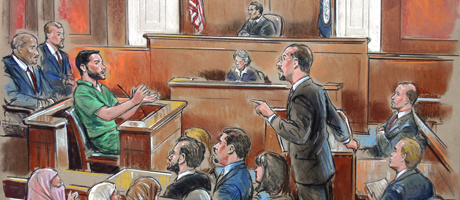Renowned courtroom sketch artist William J. Hennessy has had a front row seat at many of the major court cases of contemporary times, including the trials of the D.C. snipers, Lewis Libby and the Microsoft antitrust case. Through Nov. 30, 17 of Mr. Hennessy’s works depicting these cases and more are on exhibit at GW’s Virginia Campus.
A second exhibition at the campus features portraits of all the nation’s Supreme Court chief justices, some by noted presidential and Civil War photographer Mathew Brady.
Mr. Hennessy's work has been aired on network news programs and in national newspapers and magazines. A resident of Loudoun County, Va., he has been a featured guest on NBC Dateline, CNN, ABC News and Fox News, and recently published All Rise: Courts, Crime, and Courtroom Art.
“The current exhibit of courtroom sketches by William Hennessy, combined with the portraits of the chief justices of the Supreme Court provide yet another great opportunity for the GW and Northern Virginia communities to experience significant art and important American history,” says Craig Linebaugh, chief academic officer for the campus.
The chief justice portraits, from the Collection of the Supreme Court of the United States, include images of all 17 men who have led the high court, including John Jay, John Marshall, William Howard Taft, Charles Evans Hughes, Earl Warren, Warren E. Burger, William H. Rehnquist and John G. Roberts.
Both exhibits are part of the Regional Artist Series, a partnership between the GW Virginia Campus and Gallery 222/Loudoun Academy of the Arts Foundation to bring artists and artwork of exceptional quality to the greater Loudoun community.
“GW has formed a terrific partnership with Gallery 222/Loudoun Academy of the Arts Foundation that has enabled us to bring superb exhibits to the Virginia Campus,” says Dr. Linebaugh. “Gale Waldron, executive director of the gallery, and Joan Ziemba, director of corporate and community relations for the Virginia Campus, have worked together to create exhibits that are not only aesthetically significant but are true learning experiences for those who view them.”


